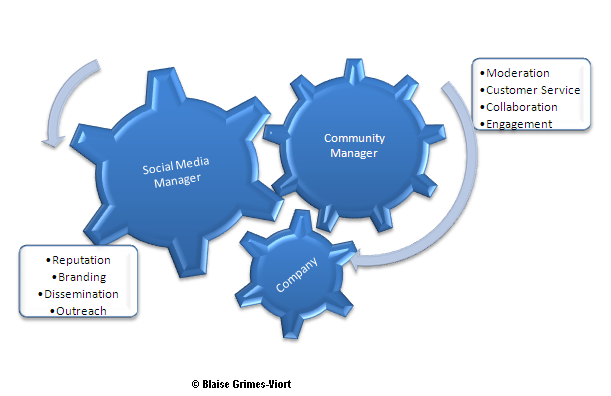Has your company ever put out a job opening for a social-media manager and then received countless resumes for people with experience as community managers – or vice versa? You’re not alone. Many people – and even many businesses – mistakenly think that the two are merely different phrases that mean the same thing.
It’s not hard to see the reason. Everyone who “likes” and comments on a Facebook page seems to be a part of a community of people who all like the subject of the page and “like” and reply to statements made by everyone else. The same could be said about those who follow a given Twitter account (although there is less interaction there because people cannot usually see when a third party tweets to someone on a given topic). Posts in LinkedIn’s Questions and Groups can evoke a lot of comments and responses. So, a company’s presences on social-media and online networks – to varying degrees – can seem to function as communities that need to be managed.
Still, there are several important differences between social media and community managers despite the overlap (that we will discuss below). As Claire BeDell notes at Sprout Social:
While they do share similar characteristics, each position requires different ways of thinking and involves very specific responsibilities. Community Managers are often the public face of brands, interacting with the community and generating buzz for their companies. Social Media Managers are strategists and communicators, with the ability to measure and analyze effectiveness.
One way to picture the difference is to imagine the subjective, overall “big picture” versus the measureable, small one.
A social-media manager focuses specifically on social media through the posting and spreading of content that suits a company’s marketing and branding goals, the monitoring and fostering of engagement on social-media networks, and the creation of ROI reports based on certain, specified metrics. A social-media manager usually posts specific items matched to a specific marketing goal of achieving specific results.
A community manager looks at the larger – and somewhat less quantifiable – picture of how people online are relating to a company and brand. This role combines the functions of listening and responding to what people are saying, being a brand champion and ambassador, and serving as the voice of the company to the online community (and vice versa!).
Although social media in general is a type of public relations, social-media and community managers each use PR in different, specific contexts. Social-media managers need to spread quality content that is aligned with a company’s desired messaging and branding as well as identify where the target demographic is present online. Community managers monitor the conversations, interact with the people online, and serve as a customer-service representative as necessary – essentially becoming a spokesperson that focuses specifically on online forums and social-media networks.
In short: Social-media managers need to be experts on the networks themselves and the associated content; community managers need to be experts on the dealing with the people on the networks.
As Tim McDonald told Rachel Strella at Social Media Today:
The main difference between Community Managers and Social Media Managers is Community Managers are more empathetic. They are the champions of the voice of the community.
A Community Manager is like a Shepherd. A community is like a flock of sheep.
A Shepherd tends to their flock. They live among the sheep, but they are not a sheep. They foster a healthy environment by allowing the sheep to work out conflict without bringing harm to each other. They keep the sheep together and moving in the direction of green pastures, so the flock can grow and expand. They protect the sheep from outside predators. The Shepherd always knows the count of the heard.
In many (but not all) instances, a company will need to have both a social-media manager and a community manager if its chosen strategy includes integrated, holistic marketing on social media, online networks, and other related locations. Both roles usually support and interact with each other along with the others at the company, and Blaise Grimes-Viort summarized the interaction in this graphic:
In a modern, holistic, marketing environment, it is not enough merely, for example, to create a Facebook page and post graphics, articles, and videos. As more and more interaction between brands and customers is occurring online, it is also important to monitor what people are saying about the company brand and posted content – and then respond as necessary in a strategic way that is aligned with your public-relations strategy and goals.
This work has become so time-consuming that many large companies will need a separate individual to focus on each side of the digital coin – and the only way to do that well is first to know what effective social-media and community managers need to do in their respective roles.
